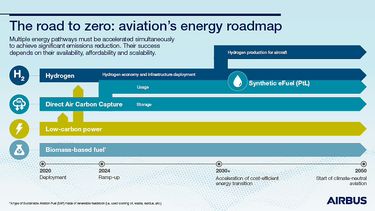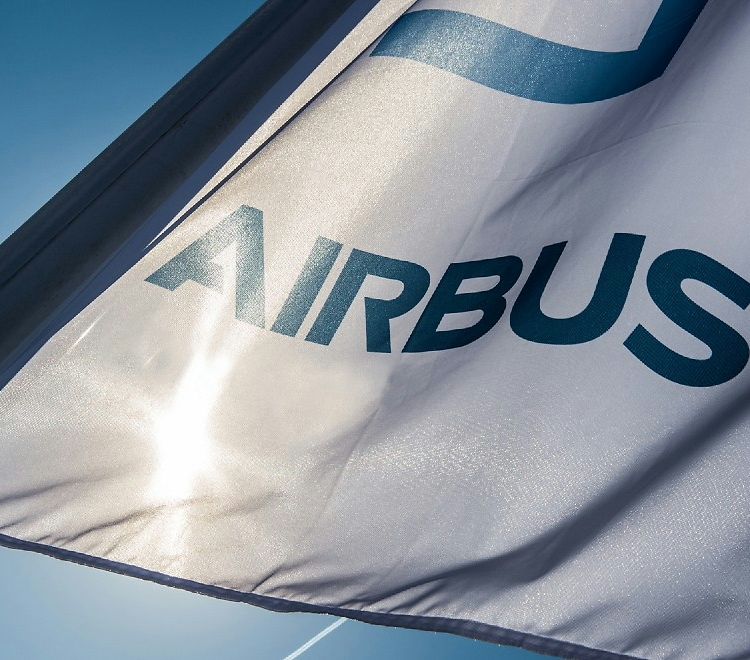The aviation industry has set its sights on climate neutrality starting from 2050. But to get there, a new energy ecosystem for aviation will need to be put into place via significant investment, collaboration and technology development. Glenn Llewellyn, Airbus VP of Zero-Emission Aircraft, describes the key energy pathways that are expected to make up this emerging ecosystem.
To achieve climate neutrality, the aviation industry will need to rapidly transform its existing energy mix. Indeed, although kerosene has remained the industry’s “go-to” fuel for decades, it will now need to make room for a variety of new energy pathways to power future aircraft.
Glenn Llewellyn has been watching with keen interest the development of these pathways across various industries, from automotive to heavy transport. Encouraged by the rapid progress, he is increasingly confident energy pathways like sustainable aviation fuel, hydrogen and Power-to-Liquid (PtL) synthetic e-fuel will all play an integral role in the aviation industry’s road to zero.
5 questions with Glenn Llewellyn, Vice-President of Zero-Emission Aircraft
Q. Airbus has laid bare its hydrogen ambition. Does this mean hydrogen is the answer to aviation’s carbon problem?
At Airbus, we’ve been clear from the beginning: there’s no “silver bullet” solution to decarbonising aviation. The aviation industry has set itself some ambitious targets to reduce its CO₂ emissions. But these targets don’t go far enough, particularly in the context of a growing aviation market. A mix of new energy pathways and fuels, including hydrogen, will be vital to achieving the disruptive CO₂ reductions the industry is targeting over the medium to long terms. This is why Airbus’ climate strategy involves accelerating several pathways simultaneously while fostering the development of a new energy ecosystem.
Q. Can you describe these energy pathways?
For one, there’s today’s sustainable aviation fuel, otherwise known as SAF, which is a biomass-based fuel (used cooking oil, waste, residue, etc.). All Airbus aircraft are certified to operate on up to a 50% SAF blend. In March, we launched a 100% SAF project that will help support SAF’s future certification for blends that exceed today’s maximum of 50%. In addition to biomass-based fuel, there are other alternative fuels that represent a major opportunity to reduce aviation’s CO₂ emissions, such as Power-to-Liquid (PtL) synthetic e-fuel made of renewable hydrogen and CO₂ captured from Direct Air Carbon Capture. We at Airbus see PtL as having huge potential, not only in terms of climate impact, but also in cost and scalability. And, of course, there’s hydrogen, a fuel we’re learning more about from the automotive and space industries. Hydrogen is likely to be a solution for several industries to meet their climate targets, and we believe aviation will be no exception.

Q. What are some of the challenges to scaling up this new energy ecosystem?
For SAF, there’s still a lot of work to do to encourage its uptake, which accounts for less than 1% of today’s flights. Incentives and long-term policies that encourage SAF use will be essential in this respect. Similarly, the global hydrogen economy is still in its infancy. The availability of green hydrogen – made using renewable energy – to fuel future aircraft is undoubtedly a key challenge, but we’ve been carefully observing the hydrogen ecosystem and are excited by the incredible progress. We expect all of this rapid development to help drive down the costs of hydrogen for aviation, while boosting its availability in the years to come.
Decarbonising aviation is a team sport, and we’re in it to win it.
- Glenn Llewellyn, Airbus VP of Zero-Emission Aircraft
Q. What is needed most to overcome these challenges?
Without a doubt: collaboration. This is why we’re collaborating closely with a network of partners – including engine manufacturers, airports, technology partners, and energy suppliers – to push the development of the various technologies to support their introduction and scale-up. Our main objective is to explore and make technically and economically viable as many alternative pathways as possible, while putting in place the infrastructure required to encourage their widespread adoption.
Q. Are you optimistic the aviation industry will be able to significantly reduce CO₂ emissions by 2050?
Yes, I’m optimistic. The road to climate-neutral aviation is already mapped out: we have identified the key energy pathways, as well as a realistic timeline in which to achieve our goal. We at Airbus strongly believe the time is now to invest in all possible avenues to reduce aviation’s climate impact, and we encourage like-minded industry players to support us in this endeavour. Decarbonising aviation is a team sport, and we’re in it to win it.
